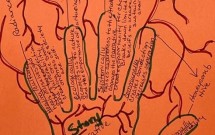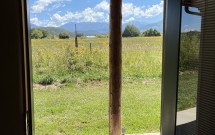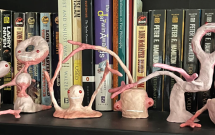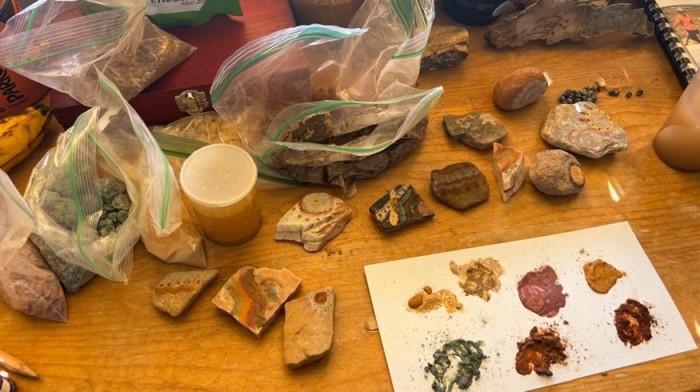
Doctoral student and artist Jamie Moon shares her journey and what influenced her to collect and make sand-painted stones and gift them to the Visionary Practice & Regenerative Leadership doctoral program faculty and her fellow doctoral students. Enjoy her unique story in her words and images.
Growing up in Tennessee, in a very traditional gift-giving family, there has always been a deep desire to give instilled in me. When I left Tennessee at 45 years old and moved across the country to Colorado, I had many questions about gifts, the Earth, the Universe, and my connection to it. My narrative was changing, as was my worldview, and my understanding of the relationship between everyone and everything.
Moving to Colorado was a rich cultural and spiritual shift in my life. The rocks and plants were all different from anything I had ever known or seen, and the colors, the colors of the soils surrounded me, everywhere I went. I began collecting soils of different colors from all over Colorado, New Mexico, and Utah. By the end of my first year of undergrad, I had been to Arizona and learned more about how Native Americans and Indigenous people use these beautiful colored soils in pottery and sculpture. I found myself on a journey, a journey of relationship, reciprocity, artistry, and spiritual connection to the Earth that I had never experienced before.
On this journey, I began exploring ways to use the soils in my artwork. I experimented with firing the soils on clay to different temperatures. I painted with the soils and researched how to create permanence in the soils on canvas. I learned about the ephemerality of this media, and how to use it to build community and reciprocate relationships with others. Little did I know at the time that this was also building a reciprocal relationship between myself and the Earth.
During my last semester of undergrad, the department chair handed me a book titled, Braiding Sweet Grass: Indigenous Wisdom, Scientific Knowledge, and the Teaching of Plants, written by Robin Wall Kimmerer (2013). I am reading this book again now in my Embodied Cosmology doctoral class. The very first chapter of this book holds the key to the understanding of gifts from an Indigenous perspective and the truth that they hold. Dr. Kimmerer offered, “A gift creates ongoing relationship” (p. 26). She went on to say, “A gift is something for nothing, it cannot be sold” (p. 27). She is speaking of sweetgrass, but for me, it meant something far more, and I began to realize the value and the meaning of a gift. “A gift that passes from hand to hand grows richer as it is honored in every exchange. That is the fundamental nature of gifts: they move, and their value increases with their passage” (Kimmerer, p. 27).
It was this book that helped me understand giving. I have read these passages at Thanksgiving dinners and to my students in the classroom. Shared them in stories, and papers, and have held them deeply in my heart for many years now.
Over time I began taking small baggies of soil and paintbrushes with me on hikes. I would sit and paint stones and leave them for hikers to find. Tiny blessings along the trail. Sometimes if there is clay or mud on the path, I will stop and make it into a heart shape, leaving it for someone to find. A tiny gift of love for passers-by. Gifts Mother Earth has given me and to us all. The gift of soil, stone, clay, and mud. Gifts that I then use artistically to create something beautiful and leave for someone else to find. Knowing that these tiny works of art will continue to move and change over time.
During my first residency at SWC, I had an overwhelming desire to share this practice with my doctoral cohort. So while hiking from the art center back up to my room one day, I began asking the Earth if she would gift me with stones to share with my cohort. Joyfully she did, and on my next hike, I requested soil or clay that I could use to paint the stones. Thankfully I had brought some of my yellow, pink, green, and red soils from home, just in case I needed them. But Mother Earth did not disappoint, and she blessed me with some clay from the arroyo that I could use as part of my gift.
On the day that we had to ourselves, I sat in my little room for an hour or so, after spending the morning in nature. I took each stone that I had collected and simply allowed my subconscious to show me the shape and colors that needed to be used on each stone. As I painted, I thought of each of my cohort members surrounded by love and light. The love from my heart, as well as the love from the Earth, sun and moon, and the energy of the universe. Stones are sacred, and they each have a story to tell. The soils were sourced and collected from Colorado, New Mexico, Arizona, and Utah. Each tiny handful of soil contains the history of all our ancestors and every living thing that has ever walked the face of this planet. Soil is sacred. After painting each stone, I sealed the soil with a small amount of organic glue. Placed each of them in a paper cup and carried them to our meeting. What an honor to share this gift with my cohort. Allowing each stone to choose its person, I handed them out in hopes that each person would see the blessing in the reciprocity of the gift.
“We are showered every day with gifts, but they are not meant for us to keep. Their life is in their movement, the inhale and the exhale of our shared breath. Our work and our joy is to pass along the gift and to trust that what we put out into the universe will always come back.” (Kimmerer, 2013, p. 104)
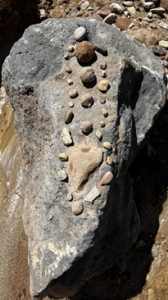
References
Kimmerer, R. W. (2013). Braiding sweetgrass: Indigenous wisdom, scientific knowledge, and the teachings of plants. Milkweed Editions.
 Southwestern College Santa Fe, NM
Southwestern College Santa Fe, NM



